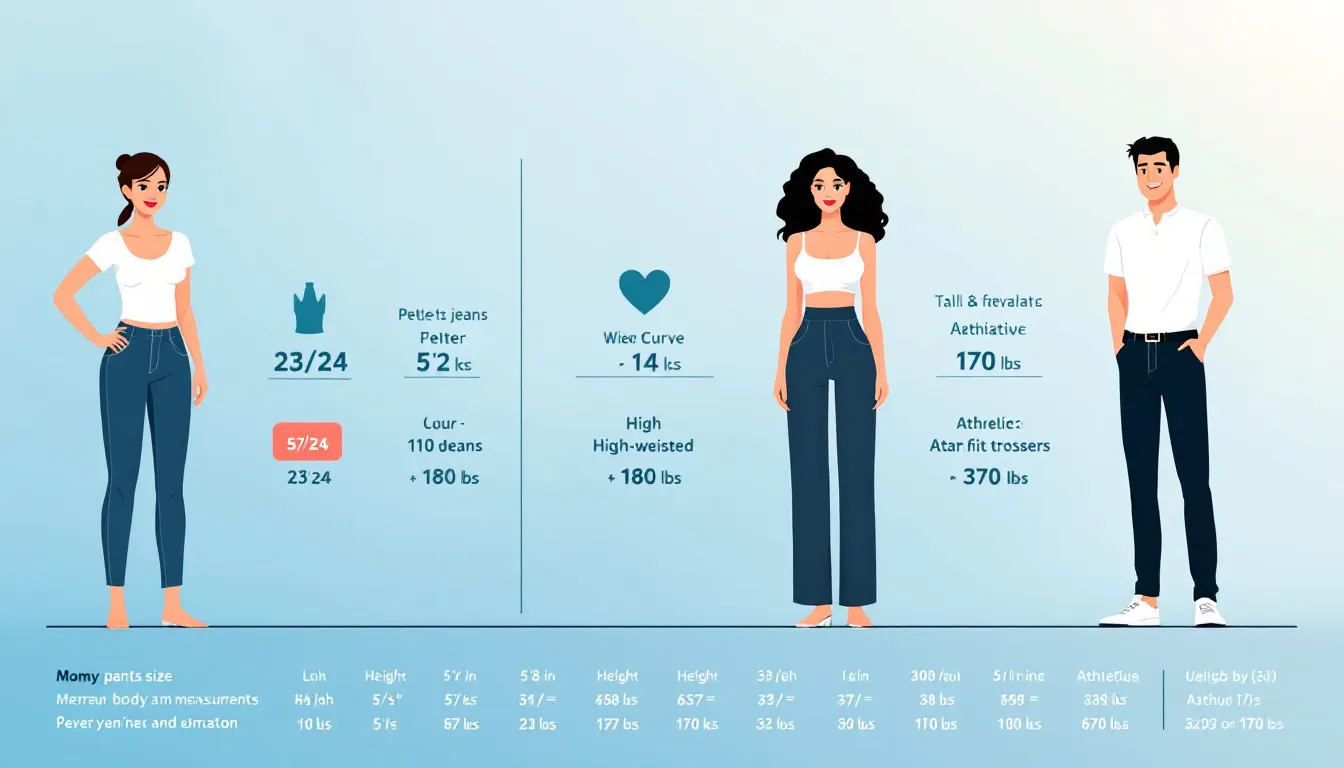Struggling to find your pant size? Accurate body measurements facilitate an easy search for the perfect fit. This article will show you how to use a women’s pant size chart, take accurate measurements, and understand different sizing systems. Get the perfect fit every time.
Understanding Women’s Pant Sizes Chart

Navigating women’s pant sizes can be a maze, as different brands and countries use various sizing systems, making consistent fits hard to find. Accurate body measurements serve as your compass, guiding you to the right size despite these variations. A size 8 in one brand might not fit the same as a size 8 in another, highlighting the importance of knowing your exact measurements.
Awareness of your body measurements not only helps in finding the perfect fit but also enhances your shopping experience. Knowing your waist, hips, and inseam measurements allows you to confidently navigate size charts and select the best-fitting pants every time. Accurate measurements simplify the search for the right size despite varying sizing systems.
Why Accurate Women’s Pant Size Measurements Matter
Accurate body measurements act as a secret weapon in your fashion arsenal, ensuring your pants fit comfortably and look great. Imagine the frustration of buying pants only to find they’re too tight or too loose—accurate measurements help you avoid such disappointments. Measuring your waist, hips, and inseam with a tape ensures you get the right size.
Proper measurements can transform your shopping experience by allowing you to bypass the trial-and-error phase and directly find well-fitting pants. This approach saves time and makes shopping more enjoyable and less stressful. Accurate measurements also facilitate an easy search for well-fitting pants, simplifying the overall process.
Common Sizing Systems
Women’s pant sizes vary significantly across international sizing systems like UK, US, and EU. For example, a UK size 10 is different from a US size 10, which can lead to confusion. Typically, UK sizes are about two sizes smaller than their US counterparts.
Specific size charts and a size guide are essential for finding the right size. These charts offer the necessary measurements and conversions to navigate different sizing standards. Understanding these differences helps you make informed decisions and avoid the hassle of returns and exchanges. Size charts simplify the search for the right size across different sizing systems.
How to Measure Your Body for Pants

Knowing your measurements is key to determining suitable sizes and fits for women’s pants. The three critical measurements are your waist, hips, and inseam. Measure against your body and not over your clothes to avoid inaccurate sizing.
Use a flexible measuring tape to confirm your measurements against online size charts before purchasing. Always compare your measurements with these charts to minimize sizing issues. Accurate measurements simplify the search for the right size when using online size charts.
Measuring Your Waist
To measure your waist, locate its narrowest part, stand upright, relax your stomach, and wrap the measuring tape around this area. Ensure the tape is snug but not too tight to avoid distorting the measurement.
This simple step ensures you get the most accurate measurement, helping you find pants that fit comfortably and securely. Accurate waist measurements also simplify the search for well-fitting pants.
Measuring Your Hips
To measure your hips, place the tape around their fullest part, ensuring it is parallel to the floor. To measure your hips correctly, stand with your feet together and use a measuring tape to find the distance from your waist to the widest part of your hips. This will help you get accurate hip measurements for sizing clothes or tracking body measurements.
This method ensures your hip measurement reflects your true size, helping you choose pants that fit well around your hips and thighs. Accurate hip measurements also simplify the search for well-fitting pants.
Measuring Inseam Length
To measure your inseam, start from the crotch and measure down to the floor without wearing shoes. For women under 5’4’’, the ideal inseam typically ranges from 25 to 31 inches, helping avoid excessive fabric dragging. A 26-inch inseam is often recommended for petite women to prevent fabric pooling at the ankles.
Using a flexible tape measure and standing straight ensures the correct length is measured. Accurate inseam measurements simplify the search for the right pant length.
Women’s Pant Size Charts: US, UK, EU, and International Conversion

Size conversion charts are essential tools for determining your size across various international sizing systems, including a size chart. These charts can vary significantly between countries and even designers.
Using brand-specific size charts can help avoid discrepancies that arise from different sizing systems. These charts simplify the search for the right size across different international sizing systems.
UK to US Conversion
Understanding UK to US size conversions helps ensure you select the right size. For example, a US size 2 corresponds to a UK size 6, and a US size 4 is equivalent to a UK size 8. This systematic conversion continues up the scale, simplifying international shopping.
Referencing these conversions ensures a proper fit without guesswork. Understanding these conversions also simplifies the search for the right size.
EU to FR and IT Conversion
In women’s clothing, an EU size 38 is equivalent to a French size 40 and an Italian size 42. Knowing these conversions is crucial when shopping for European brands.
Knowing these equivalents saves time and frustration, ensuring you pick the right size on your first try. Understanding these conversions also simplifies the search for the right size.
Finding the Right Fit in Stores and Online

Finding the right fit can be challenging due to different sizing systems. Whether shopping in stores or online, keep your measuring tape snug but not too tight to ensure accurate body measurements, leading to better fitting pants. Accurate measurements simplify the search for the right size when shopping in stores or online.
When trying on pants, consider the type of clothing you’ll wear underneath to choose pants that fit comfortably without pinching or sagging. Identifying your body type is also important, as different shapes require tailored styles for optimal fit.
Shopping In-Store
When shopping in stores, try on pants to ensure the waistband sits comfortably without digging into your skin. Stand upright, relax your stomach, and ensure the pants fit well at your natural waist. Walking around in the pants helps assess their comfort and fit while moving.
Online Shopping Tips
When shopping online, measure the inseam without wearing shoes for accurate length. If unsure about your inseam measurement, use a pair of well-fitting pants as a reference. Reading customer reviews offers valuable insights into the pants’ true size and any fit issues, simplifying the search for the right size.
Special Considerations for Different Body Types of Women

Different body shapes require specific styling techniques to enhance natural features and ensure a comfortable fit. Fabrics with some stretch can improve comfort and fit, especially for plus-sized women.
Here, we offer tailored advice for petite and plus-sized women, helping them find pants that flatter their unique proportions. Understanding your body type simplifies the search for the right size.
Petite Women Pant Size Chart
Petite women often find standard pants too long, making tailored petite sizes essential. Look for pants with shorter inseams and consider styles that elongate the legs, such as high-waisted options. Avoid overwhelming patterns to create a balanced silhouette. Understanding petite sizing simplifies the search for the right size.
Prioritize high-waisted pants to elongate your legs and achieve a balanced look.
Plus Size Pant Size Chart For Women
Plus-sized women should seek pants designed for curvier figures, focusing on styles that enhance comfort and provide a flattering silhouette. Understanding your body type is crucial in choosing clothing that flatters your shape. High-waisted styles can be particularly flattering, as they help create a defined waistline. Understanding plus sizing simplifies the search for the right size.
Choose pants with stretchable materials to enhance comfort around the waist and thighs.
Conclusion
Finding the perfect pair of pants involves understanding your body measurements, knowing the different sizing systems, and using size conversion charts. Accurate measurements can significantly enhance your shopping experience, whether you’re shopping in-store or online. By considering your body type and following specific tips, you can find pants that fit well and flatter your figure. Remember, the right pair of pants is out there—it’s just a matter of finding it with the right knowledge and tools. Accurate measurements simplify the search for the right size, making the process more efficient and less stressful.

